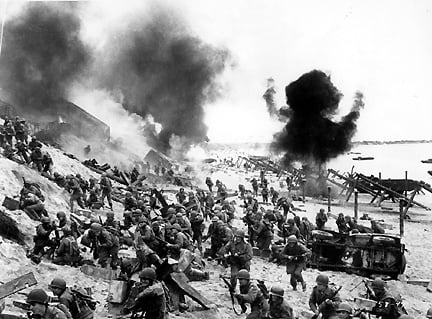WRAP SHOT

While it lacks the shocking blood-and-guts authenticity of Saving Private Ryan,1962’s epic D-Day invasion chronicle The Longest Day boasts the kind of visual spectacle and star power that is virtually impossible to reproduce today. Based on the authoritative tome of the same name by Cornelius Ryan, the mammoth $10 million film details the buildup of American, British, Canadian and French troops in England, explores the mindset of the German defenders in Normandy, and then covers key aspects of the "Operation Overlord" invasion from both sides revealing how Nazi overconfidence helped augment the strategic genius and raw courage demonstrated by Supreme Allied Commander General Dwight D. Eisenhower and the thousands of men and women serving under him.
The driving force behind the blockbuster project was legendary producer Daryl F. Zanuck, who brought in three directors (Andrew Marton, Ken Annakin and Bernhard Wicki) and four crack French cinematographers (Henri Persin, Walter Wottitz, Pierre Levent and Jean Bourgoin) to tackle various segments of the production. (Although uncredited, Zanuck himself helmed some scenes shot in the U.S.) This team effort surely helped to lend each of the picture’s primary venues (including gritty beachheads, opulent German headquarters, and war-torn French villages) their own distinct photographic style.
Filmed at 31 separate locations, much of the film’s action was staged on actual D-Day battlefields, including the beaches of Normandy and the seaside town of Ste. Mère Eglise. (It’s reported that the production was so authentic that emotionally scarred locals threw stones at the unfortunate actors dressed in German uniforms.) More filming was done in Corsica, while stage work was completed at the Studio Boulogne in Paris.
An army of extras was led into battle by a stellar array of Hollywood heroes, including John Wayne, Henry Fonda, Robert Mitchum, Richard Burton, Robert Ryan and Eddie Albert. Interestingly, some of the supporting players were real-life veterans of the Normandy invasion, including Lt. Richard Todd (who participated in the British 6th Airborne’s glider assault on the Orne River Bridge) and Pvt. Joseph Lowe (who landed on Omaha Beach with the 5th Ranger Battalion and heroically scaled the treacherous hundred-foot cliffs at Pointe du Hoc).
Here, American troops are pinned down on Omaha Beach by incessant enemy fire. In one of the film’s most remarkable shots seen from the aerial perspective of a German fighter strafing the shoreline the masterful staging of this event is clearly displayed as thousands of soldiers, ships and vehicles struggle to cross the blood-soaked stretch of sand.
Shot in CinemaScope, The Longest Day earned both Academy and Golden Globe Awards for Best Black-and-White Cinematography, as well as an Oscar for Best Special Effects.
— David E. Williams